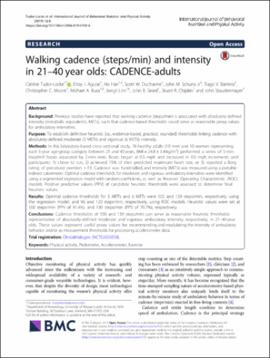| dc.contributor.author | Tudor-Locke, Catrine | |
| dc.contributor.author | Aguiar, Elroy J. | |
| dc.contributor.author | Han, Ho | |
| dc.contributor.author | Ducharme, Scott W. | |
| dc.contributor.author | Schuna, John M., Jr. | |
| dc.contributor.author | Barreira, Tiago V. | |
| dc.contributor.author | Moore, Christopher C. | |
| dc.contributor.author | Busa, Michael A. | |
| dc.contributor.author | Lim, Jongil | |
| dc.contributor.author | Sirard, John R. | |
| dc.contributor.author | Chipkin, Stuart R. | |
| dc.contributor.author | Staudenmayer, John | |
| dc.date.accessioned | 2022-04-19T20:19:40Z | |
| dc.date.available | 2022-04-19T20:19:40Z | |
| dc.date.issued | 2019-01-17 | |
| dc.identifier | oksd_han_walkingcadence(stepsmin)_2019 | |
| dc.identifier.citation | Tudor-Locke, C., Aguiar, E. J., Han, H., Ducharme, S. W., Schuna, J. M., Jr., Barreira, T. V., ... Staudenmayer, J. (2019). Walking cadence (steps/min) and intensity in 21-40 year olds: CADENCE-adults. International Journal of Behavioral Nutrition and Physical Activity, 16, Article 8. https://doi.org/10.1186/s12966-019-0769-6 | |
| dc.identifier.uri | https://hdl.handle.net/11244/335264 | |
| dc.description.abstract | Background: Previous studies have reported that walking cadence (steps/min) is associated with absolutely-defined intensity (metabolic equivalents; METs), such that cadence-based thresholds could serve as reasonable proxy values for ambulatory intensities. | |
| dc.description.abstract | Purpose: To establish definitive heuristic (i.e., evidence-based, practical, rounded) thresholds linking cadence with absolutely-defined moderate (3 METs) and vigorous (6 METs) intensity. | |
| dc.description.abstract | Methods: In this laboratory-based cross-sectional study, 76 healthy adults (10 men and 10 women representing each 5-year age-group category between 21 and 40 years, BMI = 24.8 +/- 3.4 kg/m 2 ) performed a series of 5-min treadmill bouts separated by 2-min rests. Bouts began at 0.5 mph and increased in 0.5 mph increments until participants: 1) chose to run, 2) achieved 75% of their predicted maximum heart rate, or 3) reported a Borg rating of perceived exertion > 13. Cadence was hand-tallied, and intensity (METs) was measured using a portable indirect calorimeter. Optimal cadence thresholds for moderate and vigorous ambulatory intensities were identified using a segmented regression model with random coefficients, as well as Receiver Operating Characteristic (ROC) models. Positive predictive values (PPV) of candidate heuristic thresholds were assessed to determine final heuristic values. | |
| dc.description.abstract | Results: Optimal cadence thresholds for 3 METs and 6 METs were 102 and 129 steps/min, respectively, using the regression model, and 96 and 120 steps/min, respectively, using ROC models. Heuristic values were set at 100 steps/min (PPV of 91.4%), and 130 steps/min (PPV of 70.7%), respectively. | |
| dc.description.abstract | Conclusions: Cadence thresholds of 100 and 130 steps/min can serve as reasonable heuristic thresholds representative of absolutely-defined moderate and vigorous ambulatory intensity, respectively, in 21-40 year olds. These values represent useful proxy values for recommending and modulating the intensity of ambulatory behavior and/or as measurement thresholds for processing accelerometer data. | |
| dc.format | application/pdf | |
| dc.language | en_US | |
| dc.publisher | Springer Science and Business Media LLC | |
| dc.relation.ispartof | International Journal of Behavioral Nutrition and Physical Activity, 16 | |
| dc.relation.uri | https://www.ncbi.nlm.nih.gov/pubmed/30654810 | |
| dc.rights | This material has been previously published. In the Oklahoma State University Library's institutional repository this version is made available through the open access principles and the terms of agreement/consent between the author(s) and the publisher. The permission policy on the use, reproduction or distribution of the material falls under fair use for educational, scholarship, and research purposes. Contact Digital Resources and Discovery Services at lib-dls@okstate.edu or 405-744-9161 for further information. | |
| dc.subject.mesh | Adult | |
| dc.subject.mesh | Calorimetry, Indirect | |
| dc.subject.mesh | Cross-Sectional Studies | |
| dc.subject.mesh | Exercise Test | |
| dc.subject.mesh | Female | |
| dc.subject.mesh | Gait | |
| dc.subject.mesh | Heuristics | |
| dc.subject.mesh | Humans | |
| dc.subject.mesh | Male | |
| dc.subject.mesh | Metabolic Equivalent | |
| dc.subject.mesh | Physical Exertion | |
| dc.subject.mesh | Rest | |
| dc.subject.mesh | Walking | |
| dc.subject.mesh | Young Adult | |
| dc.title | Walking cadence (steps/min) and intensity in 21-40 year olds: CADENCE-adults | |
| dc.date.updated | 2022-04-12T18:22:36Z | |
| osu.filename | oksd_han_walkingcadence(stepsmin)_2019.pdf | |
| dc.description.peerreview | Peer reviewed | |
| dc.identifier.doi | 10.1186/s12966-019-0769-6 | |
| dc.description.department | Community Health Sciences, Counseling and Counseling Psychology | |
| dc.type.genre | Article | |
| dc.type.material | Text | |
| dc.subject.keywords | Accelerometer | |
| dc.subject.keywords | Exercise | |
| dc.subject.keywords | Pedometer | |
| dc.subject.keywords | Physical activity | |
| dc.subject.keywords | Clinical Research | |
| dc.subject.keywords | 11 Medical and Health Sciences | |
| dc.subject.keywords | 13 Education | |
| dc.subject.keywords | Public Health | |
| dc.rights.license | https://creativecommons.org/licenses/by/4.0/ | |
| dc.identifier.author | ORCID: 0000-0003-4342-5909 (Tudor-Locke, C) | |
| dc.identifier.author | ScopusID: 7003557760 (Tudor-Locke, C) | |
| dc.identifier.author | ScopusID: 36166452400 (Aguiar, EJ) | |
| dc.identifier.author | ORCID: 0000-0003-4241-7317 (Han, H) | |
| dc.identifier.author | ScopusID: 57191291072 (Han, H) | |
| dc.identifier.author | ScopusID: 57045640200 (Ducharme, SW) | |
| dc.identifier.author | ScopusID: 36802535500 (Schuna, JM) | |
| dc.identifier.author | ScopusID: 26634737300 (Barreira, TV) | |
| dc.identifier.author | ScopusID: 57203851316 (Moore, CC) | |
| dc.identifier.author | ScopusID: 28367481600 (Busa, MA) | |
| dc.identifier.author | ScopusID: 56797135900 (Lim, J) | |
| dc.identifier.author | ScopusID: 7003755891 (Sirard, JR) | |
| dc.identifier.author | ScopusID: 6701797467 (Chipkin, SR) | |
| dc.identifier.author | ScopusID: 6603461077 (Staudenmayer, J) | |
